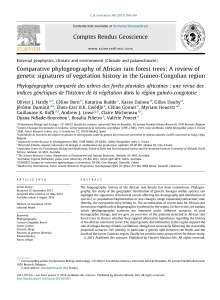Hardy O.J., Born C., Budde K., Daïnou K., Dauby G., Duminil J., Ewedje E.E., Heuertz M., Koffi G.K., Lowe A., Micheneau C., Ndiade Bourobou D., Pineiro R., Poncet V.
The biogeographic history of the African rain forests has been contentious. Phylogeography, the study of the geographic distribution of genetic lineages within species, can highlight the signatures of historical events affecting the demography and distribution of species (i.e. population fragmentation or size changes, range expansion/contraction) and, thereby, the ecosystems they belong to. The accumulation of recent data for African rain forests now enables a first biogeographic synthesis for the region. In this review, we explain which phylogeographic patterns are expected under different scenarios of past demographic change, and we give an overview of the patterns detected in African rain forest trees to discuss whether they support alternative hypotheses regarding the history of the African rain forest cover. The major genetic discontinuities in the region support the role of refugia during climatic oscillations, though not necessarily following the classically proposed scenarios. We identify in particular a genetic split between the North and the South of the Lower Guinean region. Finally we provide some perspectives for future study.
Consultez la notice complète de l’article sur ORBi

